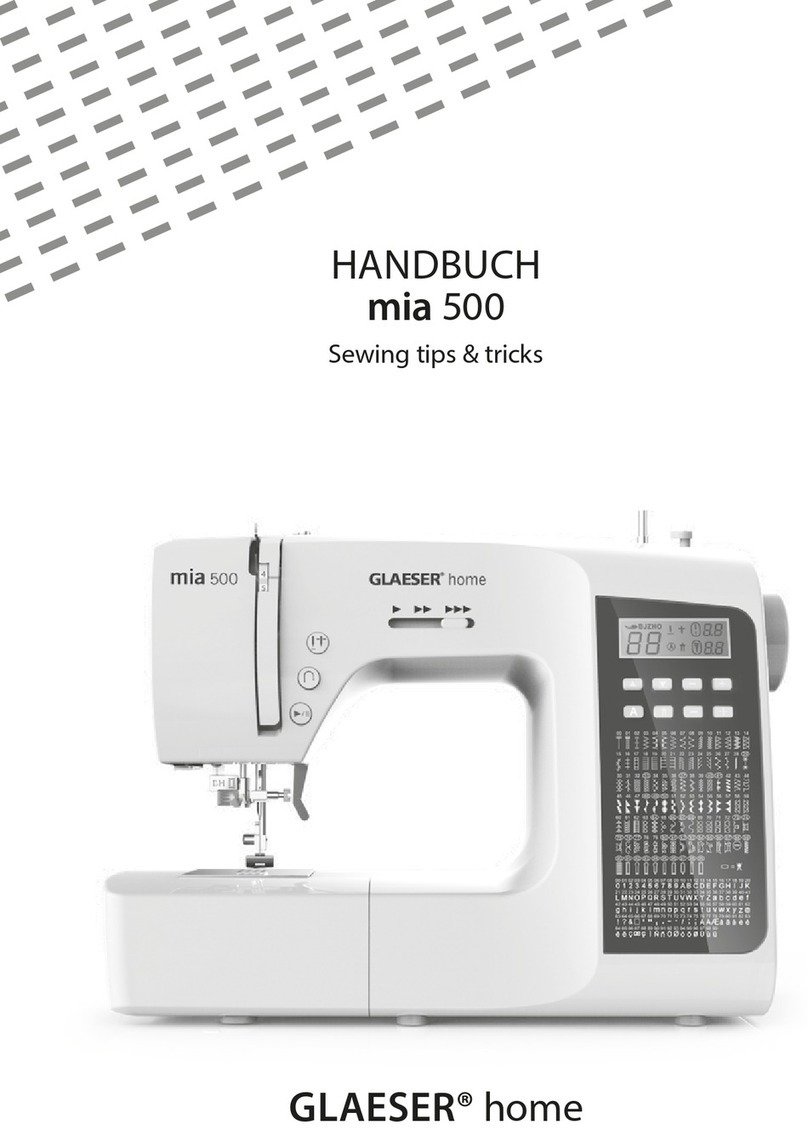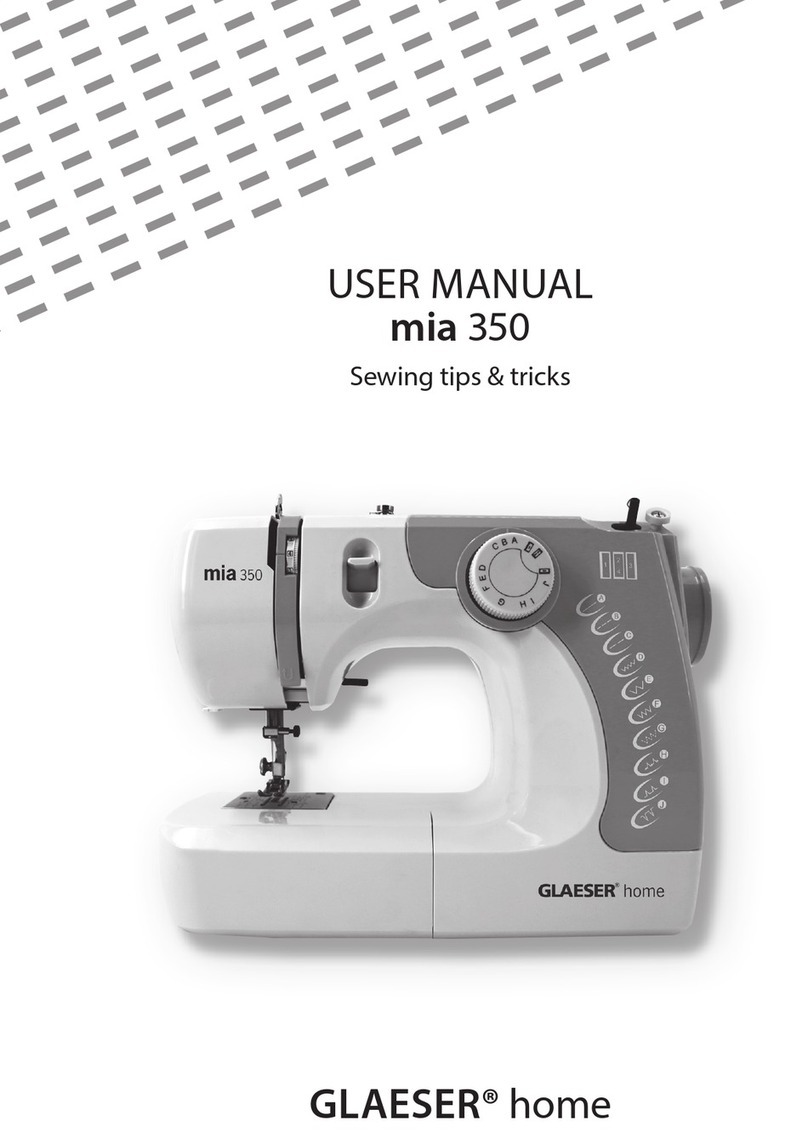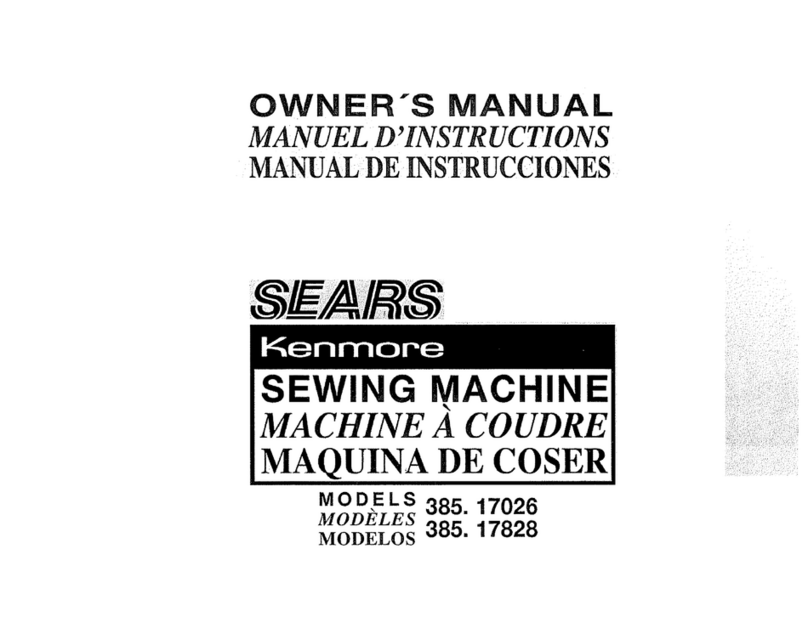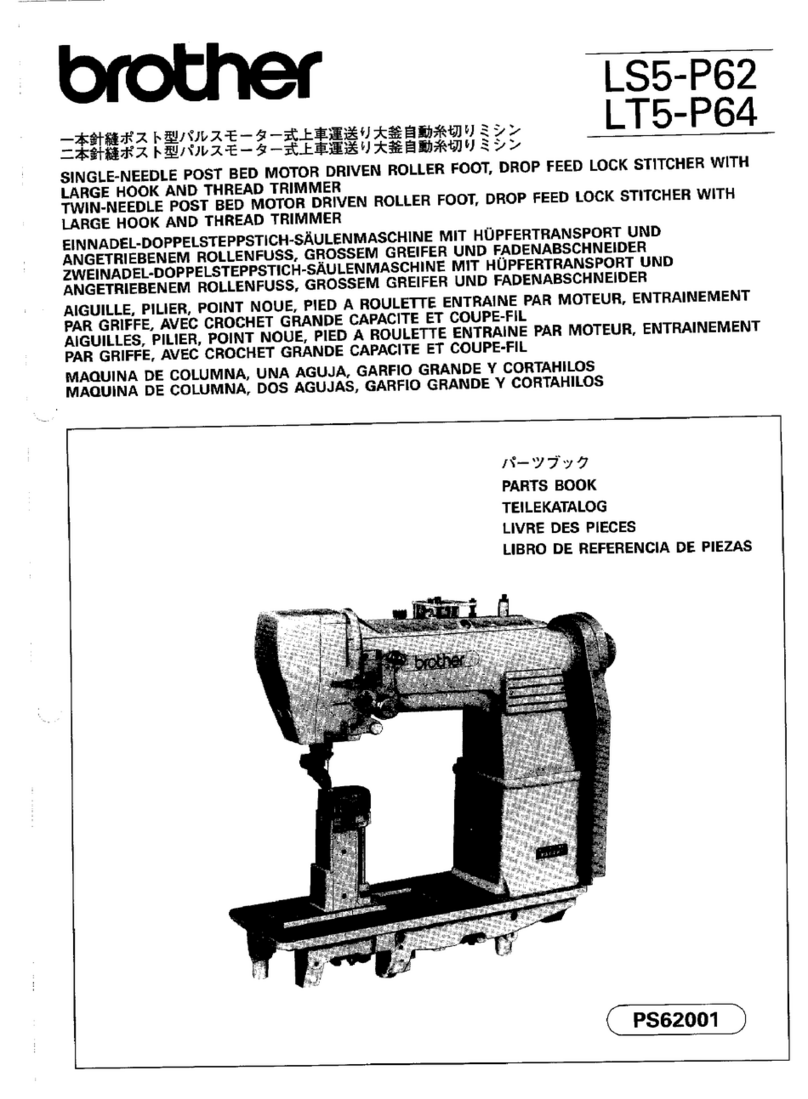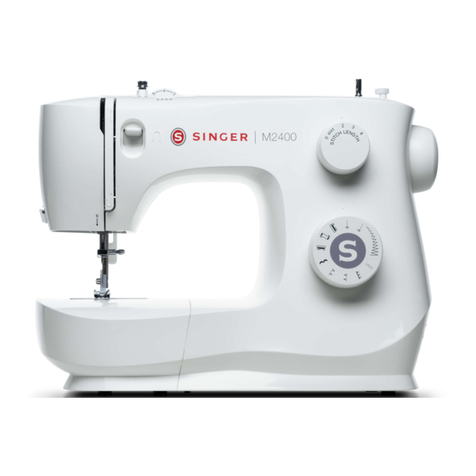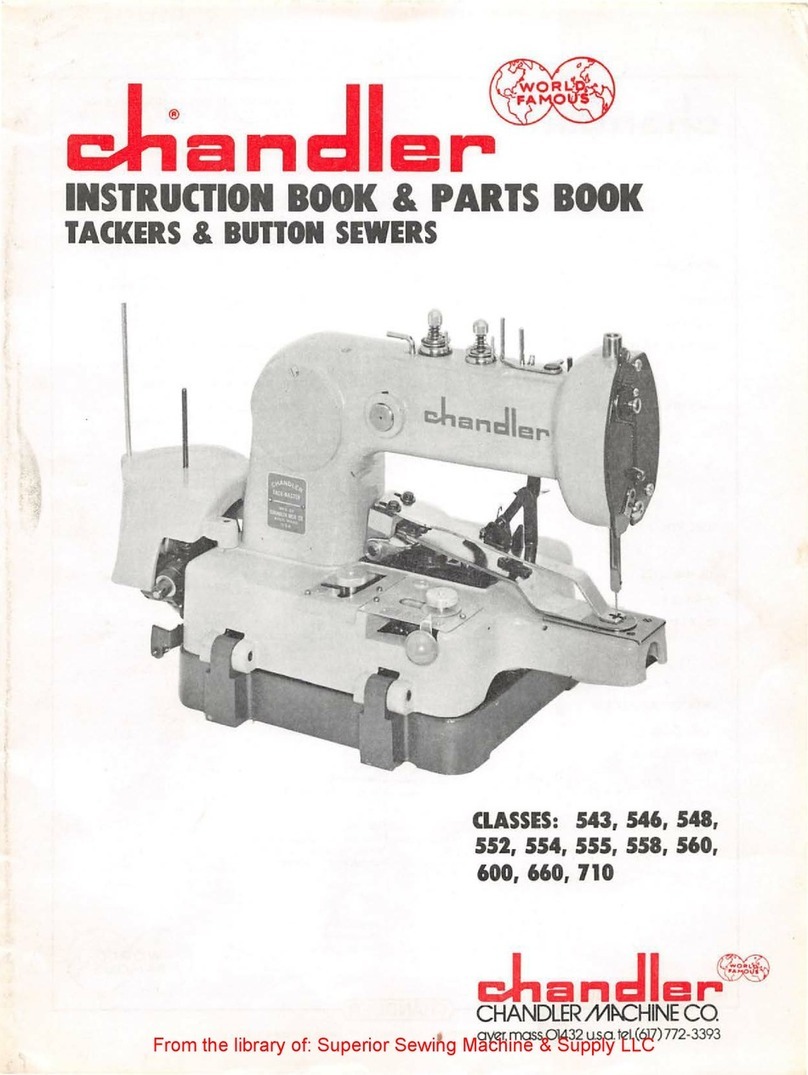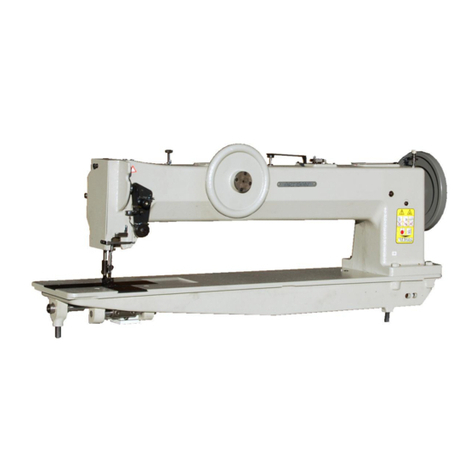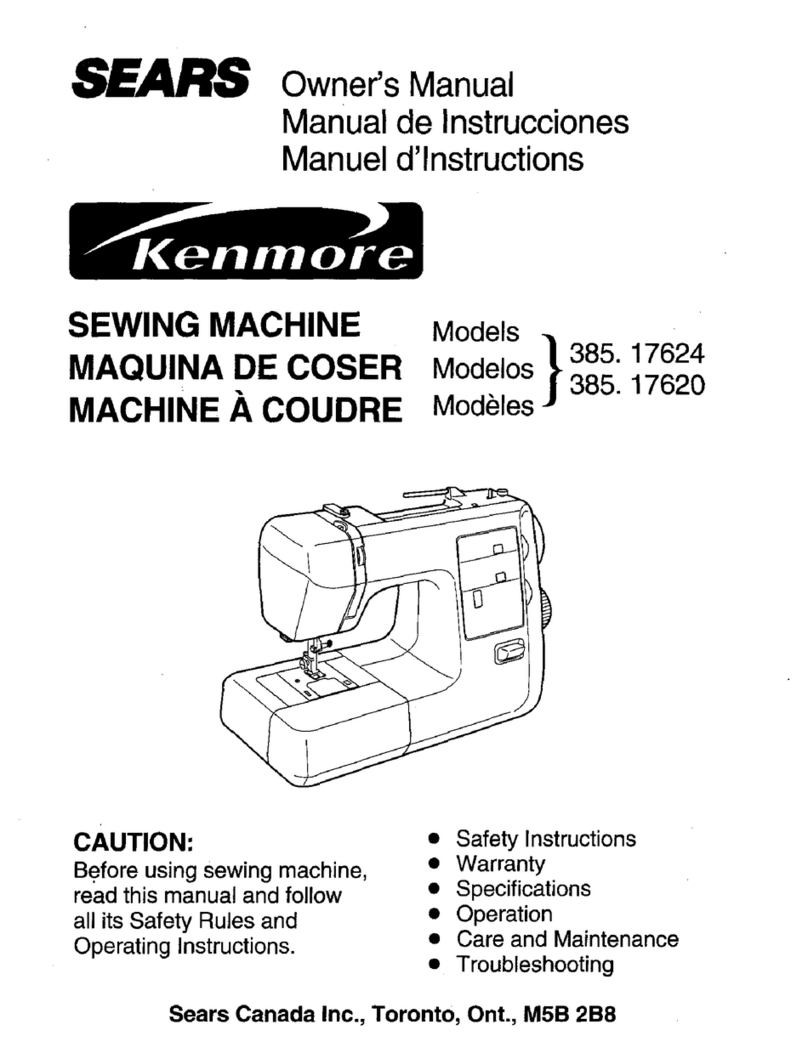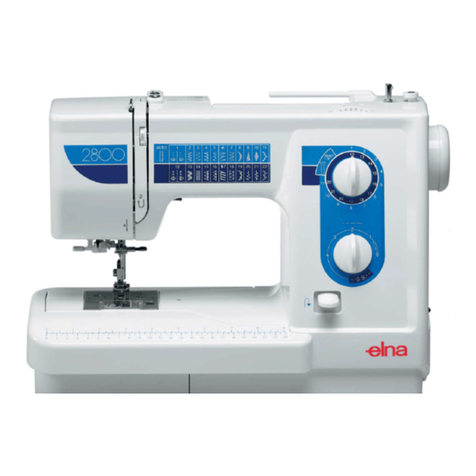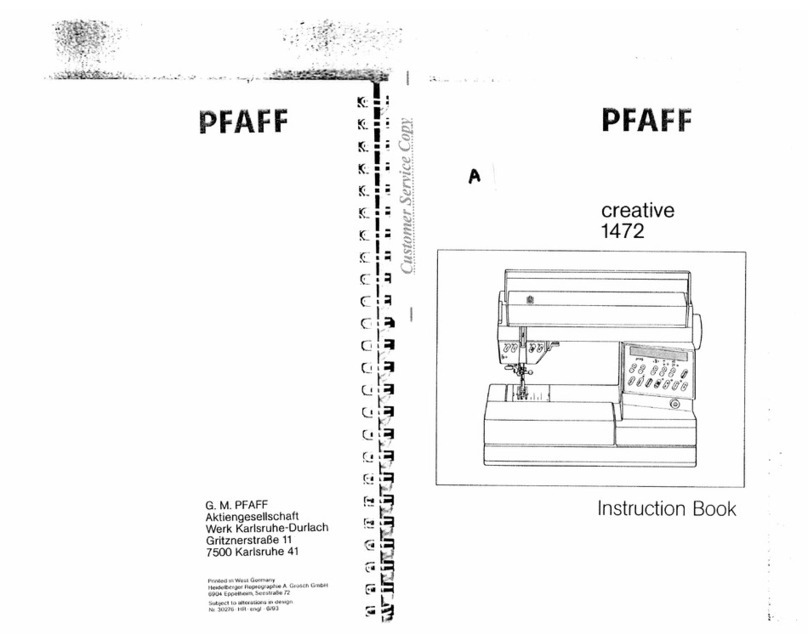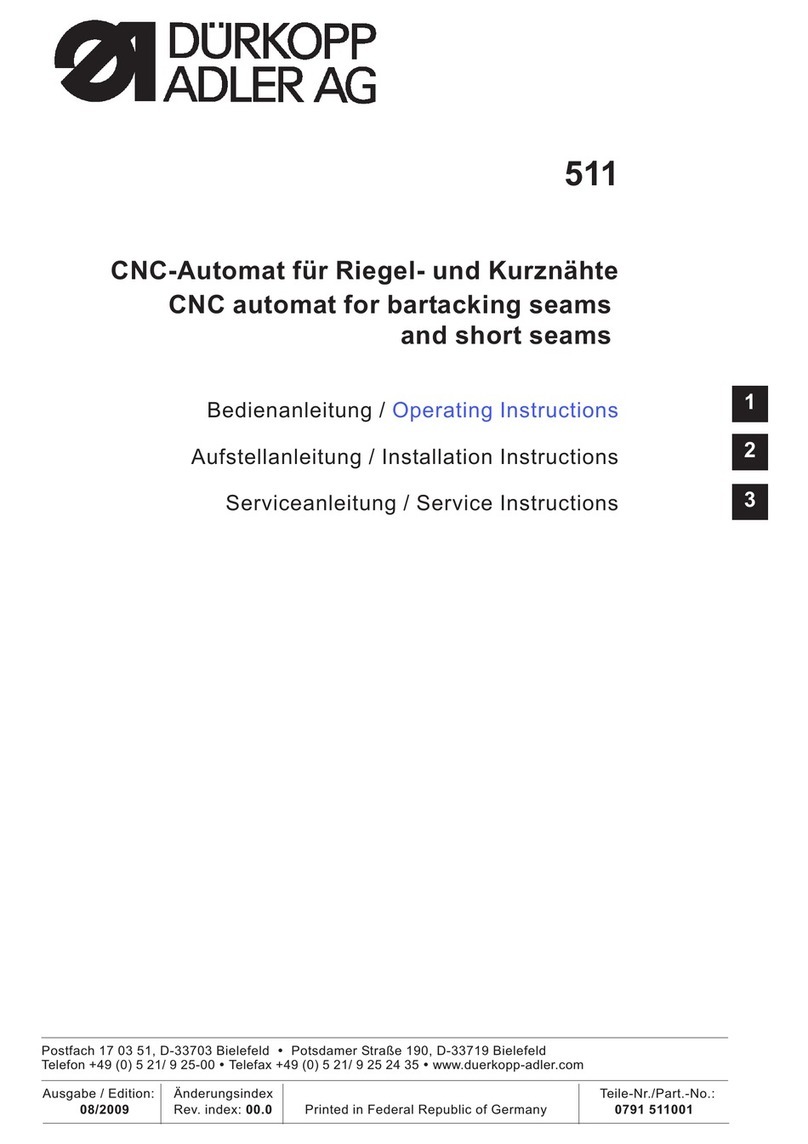Glaeser home mia 300 User manual

INSTRUCTION MANUAL
mia 300
Tips & Tricks around sewing
GLAESER® home

2
IMPORTANT SAFETY INSTRUCTIONS
When using an electrical appliance, basic safety precautions should always be followed, including
the following.
Read all instructions before using this sewing machine.
DANGER – To reduce the risk of electric shock:
1. Do not allow to be used as a toy. Close attention is necessary when this sewing machine is used
by or near children.
2. This appliance can be used by children aged from 8 years and above and persons with reduced
physical, sensory or mental capabilities or lack of experience and knowledge if they have been
given supervision or instruction concerning use of the appliance in a safe way and understand
the hazards involved. Children shall not play with the appliance. Cleaning and user maintenance
shall not be made by children without supervision.
3. Use this sewing machine only for its intended use as described in this manual. Use only attach-
ments recommended by the manufacturer as contained in this manual.
4. Never operate this sewing machine if it has a damaged cord or plug, if it is not working properly,
if it has been dropped or damaged, or dropped into water. Return the sewing machine to the
nearest authorized dealer or service center for examination,repair, electrical or mechanical
adjustment.
5. Never operate the sewing machine with any air openings blocked. Keep ventilation openings of
the sewing machine and foot control free from the accumulation of lint, dust, and loose cloth.
6. Never drop or insert any object into any opening.
7. Do not use outdoors.
8. Do not operate where aerosol (spray) products are being used or where oxygen is being admin-
istered.
9. To disconnect, turn switch to the o (”O”) position, then remove plug from outlet.
10. Do not unplug by pulling on cord. To unplug, grasp the plug, not the cord.
11. Keep ngers away from all moving parts. Special care is required around the sewing machine
needle.
12. Never sew with a damaged needle plate as this can cause needle to break.
13. Do not use bent needles.
14. Do not pull or push fabric while stitching. It may deect the needle causing it to break.
15. Switch the sewing machine o ("0") when making any adjustments in the needle area, such as
threading needle, changing needle, threading bobbin, or changing presser foot, etc.
16. Always unplug sewing machine from the electrical outlet when removing covers, lubricating, or
when making any other user servicing adjustments mentioned in the instruction manual.
17. Attention the following to avoid injury:
· Switch o or unplug the appliance when leaving it unattended;
· Unplug the appliance before carrying out maintenance.

3
CAUTION: Moving parts-To reduce risk of injury, switch o before servicing. Close cover before
operating machine.
SAVE THESE INSTRUCTIONS
This appliance complies with EMC Directive 2014/30/EU covering the electromagnetic compatibility.
Please note that on disposal, this product must be safely recycled in accordance with
relevant National legislation relating to electrical/ electronic products. If in doubt please
contact your retailer for guidance.

4
TABLE OF CONTENTS
Important safety instructions.................................................................................................................2
Knowing your sewing machine .............................................................................................................7
Main parts...................................................................................................................................................... 7
Accessories ....................................................................................................................................................8
Power line cord/foot control .................................................................................................................8
Power/light switch......................................................................................................................................8
Setting up your machine..........................................................................................................................8
Converting to free-arm sewing .............................................................................................................9
Presser foot lifter.........................................................................................................................................9
Reverse sewing lever .................................................................................................................................9
Dropping the feed dogs...........................................................................................................................9
Seam guide line.........................................................................................................................................10
Setting spool pins.....................................................................................................................................10
Winding the bobbin.................................................................................................................................10
Removing or replace the bobbin case..............................................................................................11
Threading the bobbin case ...................................................................................................................11
Changing the presser foot.....................................................................................................................12
Attaching the seam guide(optional)..................................................................................................12
Threading the machine ..........................................................................................................................13
How to thread the double needle ......................................................................................................13
Using automatic needle threader.......................................................................................................14
Drawing up bobbin thread ...................................................................................................................15
Balancing top thread tension...............................................................................................................15
Needle, thread and fabric chart...........................................................................................................16
Changing the needle...............................................................................................................................16
Pattern selector dial.................................................................................................................................17
Selecting stretch stitch patterns .........................................................................................................17
Stitch length dial .......................................................................................................................................17
Useful sewing tips.....................................................................................................................................18
Trial sewing..................................................................................................................................................18
Changing the sewing direction...........................................................................................................18

5
Sewing curves ............................................................................................................................................18
Sewing thick fabrics .................................................................................................................................18
Sewing elastic fabric or the fabric that is easy to cause skipping stitches ..........................18
Sewing thin fabric or silk ........................................................................................................................18
Sewing stretch fabrics.............................................................................................................................18
Straight stitch .............................................................................................................................................19
Zigzag stitch................................................................................................................................................20
Overlock stitch ...........................................................................................................................................20
Overedge stitch .........................................................................................................................................20
Tricot stitch ..................................................................................................................................................21
Triple strength stitch................................................................................................................................21
Sewing buttons..........................................................................................................................................22
Buttonhole stitch ......................................................................................................................................23
Buttonhole stitch ......................................................................................................................................24
Zipper application ....................................................................................................................................24
Blind stitch...................................................................................................................................................25
Decorative stitching.................................................................................................................................26
Shell tuck stitch..........................................................................................................................................26
Stretch stitches...........................................................................................................................................26
Decorative satin stitch.............................................................................................................................27
Smocking .....................................................................................................................................................27
Box stitch......................................................................................................................................................28
Free seam.....................................................................................................................................................28
Care of your machine...............................................................................................................................29
Dismantling and assembling shuttle race.......................................................................................29
To assembling the shuttle race............................................................................................................30
Cleaning the feed dogs...........................................................................................................................30
Oiling the machine...................................................................................................................................31
Oiling the connecting rod .....................................................................................................................32
Troubleshooting........................................................................................................................................33

6

7
KNOWING YOUR SEWING MACHINE
MAIN PARTS
1. Stitch length dial
2. Pattern selector dial
3. Thread tension control dial
4. Face cover
5. Thread take up lever
6. Thread guide
7. Bobbin winder thread guide
8. Carry handle
9. Spool pins
10. Small top cover
11. Hand wheel
12. Appliance inlet
13. Power switch
14. Reverse stitch lever
15. Accessories box cover
12
98
7
6
5
4
2
1
3
10
11
15 14 13
17
18
19
16
20
21
22
23 24 25 26 27
28
29
30
31
12
98
7
6
5
4
2
1
3
10
11
15 14 13
17
18
19
16
20
21
22
23 24 25 26 27
28
29
30
31
12
98
7
6
5
4
2
1
3
10
11
15 14 13
17
18
19
16
20
21
22
23 24 25 26 27
28
29
30
31
16. Bobbin winder stopper
17. Bobbin winder spindle
18. Thread cutter
19. Accessories box body
20. Rear cover
21. Automatic needle threader
22. Needle threader Thread Guide
23. Needle bar thread guide
24. Presser foot screw
25. Needle
26. Presser foot
27. Needle plate
28. Feed dogs
29. Presser foot holder
30. Needle clamp screw
31. Press foot lifter

8
ACCESSORIES
1. Bobbins (3pcs)
2. Needle box (needles 3 pcs and
twin needle 1 pcs)
3. Multi-function screwdriver
4. Seam guide
5. Ripper / Brush
6. Buttonhole foot
7. Guide presser foot
8. Zipper foot
9. Button tting foot
SETTING UP YOUR MACHINE
Be sure to wipe o any surplus oil from needle
plate area before using your machine the rst
time.
POWER LINE CORD/ FOOT CONTROL
Make sure that the sewing machine is turned
o (the power switch is set to “O”), and then
connect the plug of the power line and into the
appliance inlet and your wall outlet.
Sewing speed can be varied the foot control.
The harder you press on the control, the faster
machine runs.
POWER/LIGHT SWITCH
Your machine will not operate until the power/
light switch is turned on. The same switch
controls both the power and the light.
When servicing the machine, or changing nee-
dles, etc., machine must be disconnected from
the power supply.
2
13
5
4
7
689
Strom-/Lichtschalter
„OFF“
Strom-/Lichtschalter
„ON“
2
13
5
4
7
689
Power/light switch
“OFF”
Power/light switch
“ON”
2
13
5
4
7
689
Strom-/Lichtschalter
„OFF“
Strom-/Lichtschalter
„ON“
2
13
5
4
7
689
Strom-/Lichtschalter
„OFF“
Strom-/Lichtschalter
„ON“
The foot that comes on your sewing machine
is called zigzag foot and will be used for the
majority of your sewing.
NOTE: When foot control is disconnected, the
machine will not operate.
NOTE: Always disconnect the machine from
power supply by removing the plug from the
wall-outlet.

9
CONVERTING TO FREEARM SEWING
Your machine can be used either as a at-bed or
as a free-arm model.
With the extension table in position, it provides
a large working surface as a standard at-bed
model. To remove the extension table, hold it
rmly with both hands and pull it o to the left
as shown. To replace, slide the extension table
back into place until it clicks.
With the extension table removed the machine converts into a slim free-arm model for sewing
children’s clothes, cus, trouser legs, and other hard-to-reach places.
PRESSER FOOT LIFTER
There are three positions for your presser foot.
1. Lower the presser foot to sew.
2. Raise the lifter to the middle position to
insert or remove fabric.
3. Lift it to its highest position to change the
presser foot or to remove thick fabric.
REVERSE SEWING LEVER
As long as you are pressing down this button
while sewing, the machine will feed the fabric
backwards.
DROPPING THE FEED DOGS
1. For dropping the feed dogs, press down
lever and move it to the direction of arrow
as illustrated.
2. To raise the feed dogs, press down the lever
and move it to the direction or arrow as
illustrated.
Feed dogs must always be up for normal
sewing.
2
1
3
12

10
SEAM GUIDE LINE
The numbers on the needle plate indicate the
distance between the center needle position
and the indicating line.
The numbers in the front indicate in Millime-
ters. The numbers in the back indicate in inches.
SETTING SPOOL PINS
The spool pins are used for holding the spool of
thread in order to feed thread to the machine.
To use, pull up the spool pin. Push down for
storage.
WINDING THE BOBBIN
1. Place a spool of thread on the left spool pin.
Pull the thread out from the spool and place
it through thread guide as shown in illustra-
tion. Put end of thread through the hole in
bobbin as shown.
2. Push the bobbin wider shaft to far left
position, if it is not already there. Place
bobbin onto the bobbin wider shaft with
end of thread coming from top of bobbin.
Push bobbin winder shaft to the right until it
clicks. Hold onto end of thread.
3. Start machine. Bobbin will automatically
stop turning when completely lled. Push
shaft to the left to remove bobbin and cut
thread.
2
1
3

11
REMOVING OR REPLACE THE BOBBIN CASE
1. Refer to page 9 to remove the Extension table, raise the needle by
turning the hand wheel toward you, then open the shuttle cover.
2. Take out bobbin case holding the latch (Fig 2).
3. When installing the bobbin case, the pin on the case should t into
the gap of the shuttle race.
THREADING THE BOBBIN CASE
1. Install the bobbin into bobbin case. Make sure the thread unwinds in
the direction of arrow.
2. Pull the thread into the groove in the bobbin case slot.
3. Now pull the thread under the tension spring and into the delivery eye.
1
2
3Stift
1
2
3Stift
1
2
3Gap
Note: Leave about 10cm (4 inches) of the thread hanging out of the
bobbin case. When you pull the thread, the bobbin should spin clock-
wise.
1
2 3
1
2
3
1 2
3
Note: Be sure to disconnect the power supply before operating the
machine.

12
ATTACHING THE SEAM GUIDEOPTIONAL
Attach the seam guide in the slot as illustrated. Adjust according to need
for hems pleats etc.
CHANGING THE PRESSER FOOT
1. Turn the hand wheel toward you to raise the needle to its highest position. Raise the presser
foot.
2. Press the lever on the back of the presser foot holder. The presser foot will drop o.
3. Place the presser foot so the pin on the foot lies just under the groove of the holder. Lower the
presser foot holder to lock the foot in place.
1
23
1
2
3
12
3

13
THREADING THE MACHINE
Raise take-up lever to its highest position by
turning hand wheel toward you. Raise presser
foot. Place spool on spool pin as shown, with
thread coming from the back of the spool.
1. Draw thread into thread guide using both
hands.
2. Draw thread down into the tension area and
around the check spring holder.
3. Firmly draw thread up and through take-up
lever from right to left.
4. Then draw thread down and slip it into the
lower thread guide.
5. Do not block the thread into double needle
spring.
6. Draw thread down and slip it into needle bar
thread guide.
7. Thread needle eye from front to back.
HOW TO THREAD THE DOUBLE NEEDLE
1. Thread the left needle according to the way
of threading single needle from step one to
step ve, then x the thread into the double
needle spring as point 5 in the right picture.
Draw thread down and slip it into needle bar
thread guide 6. Finally thread into the left
needle eye from front to back.
2. Thread the right needle according to the
way of threading single needle from step
one to step nine.
Note: Cut the thread end with sharp scissors
for easier needle threading.
Note: Be sure to thread the left needle thread
rstly then thread the right needle thread. Put
the thread spool on the spool pin, make sure
that the left thread will run anti-clockwise, the
right thread will run clockwise.
1
2
3
5
6
4
7
31
4
2
5
67
1
2
3
5
6
4
7
31
4
2
5
67
5
4
Left needle thread Rightneedle thread
1
3
4
2
5
6
8
7

14
USING AUTOMATIC NEEDLE THREADER
Raise the needle to its highest position by rotat-
ing the hand wheel towards you.
1. Hook thread to thread guide as illustrated.
2. Pull down lever while holding the end of
thread.
3. Rotate the lever to the rear of the machine.
4. Guide thread into hooked end and pull the
thread upward.
5. Return the lever and needle will be threaded
automatically.
6. Release the lever and pull thread away from
you.
Note: For smooth threading it is recommend-
ed you select straight stitching when using
the needle threader.
Note: Automatic needle threader is only appli-
cable for zigzag presser foot.
Automatic needle threader cannot be used for
double needle.
123
456

15
Note: In order to obtain better zigzag stitches,
the top thread tension should be slightly
weaker than the bobbin thread tension. That
means, the top thread should appear slightly
on the reverse side of the fabric, but the
bobbin thread cannot appear on the top side
of the fabric.
DRAWING UP BOBBIN THREAD
1. Raise the presser foot and hold the needle thread lightly with you left hand.
2. Turn the hand wheel slowly towards you with your right hand until the needle goes down and
continue turning the hand wheel until the take-up lever is at its highest position.
Lightly draw up the needle thread forming a loop of the bobbin thread.
3. Pull 15cm (6 inches) of both thread back and under the presser foot.
BALANCING TOP THREAD TENSION
The top thread and the bobbin thread should
interlock in the center of two layers of fabric in
straight seams.
Set the desired number of the thread tension
dial at setting mark.
Normal position = 4
Tighten the needle thread tension by moving
the dial to a higher number.
Loosen the needle thread tension by moving
the dial to a lower number.
1
2
3

16
NEEDLE, THREAD AND FABRIC CHART
Your fabric will determine the choice of a needle and thread. The following table is a practical
guide to needle and thread selection.
Always refer to it before a new sewing project. And be sure to use the same size and type of thread
in the bobbin as in the top thread supply.
CHANGING THE NEEDLE
1. Raise the needle by turning hand wheel
toward you and lower the presser foot.
2. Rotate the needle clamp screw toward you
(counter-clockwise) to loosen the needle.
3. Remove the needle from the clamp.
4. Insert the new needle into the needle clamp
with the at side away from you.
5. When inserting the needle into the clamp,
push it up as far as it will go.
6. Tighten the clamp screw clockwise rmly
with the screwdriver.
Check you needles frequently for barbed or
blunted points. Snags and runs in knits, ne
silks and silk- like fabrics are permanent and are
almost always caused by damaged needle.
Note: Tighten snugly, but do not over tighten.
Helpful Hint: Placing a scrap of fabric under
the presser foot and lowering the presser foot
makes it easier to change the needle and will
preclude dropping the needle into the needle
plate slot.
Kind Fabric Threads Needle size
Light Weight Crepe de chine, Voile Lawn,
Organdy, Georgette, Tricot
Fine Silk, Fine Cotton, Fine
Synthetic, Fine Cotton
Covered Polyester
130/705H
60 – 80
Medium Weight Linens, Cotton, Pique, Serge,
Double knits, Percale
50 Silk, 50~80 Cotton,
50~60 Synthetic, 50~60
Cotton Covered Polyester
130/705H
80 – 90
Heavy Weight Denim, Tweed, Gabardine,
Coating, Drapery and Up-
holstery Fabric
50 Silk, 40~50 Cotton,
40~50 Synthetic, 40~50
Cotton Covered Polyester.
130/705H
90 – 100
Always disconnect the machine from
power supply by removing the plug
from the wall-outlet.
1
6542 3

17
PATTERN SELECTOR DIAL
Raise the needle above the fabric and select the desired pattern at the setting mark by turning the
pattern selector dial.
SELECTING STRETCH STITCH PATTERNS
When sewing stretch, set the stitch length dial at “SS”. When forward and reverse feeds become
unbalanced depending upon the type of fabric, correct the hand as follows.
When patterns are compressed, correct it by turning the dial toward “+”.
When patterns are drawn out, correct it by turning the dial toward”-”.
STITCH LENGTH DIAL
The higher the number, the longer the stitch length. You can select the suitable stitch length for
most fabric.
K
L
4
3
A
B
C
D
E
G
H
I
J
F
1
2
IJKL
H
1
2
4
3
ABCDEFG

18
USEFUL SEWING TIPS
Various ways to achieve better sewing results
are described below. Refer to these tips when
sewing.
TRIAL SEWING
Use dierent stitch width and length for trial
sewing. When you have nished, select the
best looking stitch width and length for correct
sewing.
For the trial sewing, use a piece of fabric and
thread that are the same as those used for
your project, and check the thread tension and
stitch length and width. Since the results dier
depending on the type of stitching and the
number of fabric layers sewn, perform the trial
sewing under the same conditions that will be
used with your project.
CHANGING THE SEWING DIRECTION
Stop the machine and turn the hand wheel
toward you to bring the needle down into the
fabric. Raise the presser foot. Pivot the fabric
around the needle to change sewing direction
as desired. Lower the presser foot and continue
sewing.
SEWING CURVES
1) Stop sewing, and then slightly change the
sewing direction to sew around the curve.
2) When sewing along a curve while using a
zigzag stitch, select a shorter length in order to
obtain a ner stitch.
SEWING THICK FABRICS
If the fabric does not t under the presser
foot
Raise the presser foot even higher to bring the
presser foot to its highest position. Then feed
the fabric under the presser foot. (See page 9 to
Raise the presser foot.)
SEWING ELASTIC FABRIC OR THE FAB
RIC THAT IS EASY TO CAUSE SKIPPING
STITCHES
Use round head needle and bigger stitch
length. If necessary, add one layer of lining
cloth under the fabric for better sewing.
SEWING THIN FABRIC OR SILK
When sewing thin fabric or silk, the stitch may
depart from correct direction or cannot feed
the fabric correctly. If so, add one layer of lining
cloth under the fabric for better sewing.
SEWING STRETCH FABRICS
First, baste the piece of fabric together, and
then sew without stretching the fabric.
FREE ARM SEWING
When sewing tube fabric or the part cannot
reach, use the free arm sewing function (For
detail, refer to page 9).

19
STRAIGHT STITCH
Wählen Sie die Position Ihrer Nadel:
Pos. A: in der Mitte
Pos. B: links (wenn der Sto entlang der rechten Kante des Füßchens geführt wird, entsteht eine
Nahtbreite von 1 cm)
Raise the presser foot and position the fabric
next to a stitching guide line on the needle
plate. Lower the needle into the fabric. Lower
the presser foot and smooth the thread towards
the back. Depress the foot control. Gently guide
the fabric along the guide line letting the fabric
feed by itself.
For fastening the ends of seams, press the
reverse stitch button and sew several reverse
stitches. Raise the presser foot and remove the
fabric, drawing the threads to back.
Schneiden Sie die Fäden am Fadenschneider
ab (Seite 7 Punkt 19), um die nächste Naht zu
beginnen.
A
B
2 ~ 6
1 .5 ~ 4
Machine Setting
1

20
ZIGZAG STITCH
Simple zigzag stitching is widely used for over-
castting, sewing on buttons etc.
OVERLOCK STITCH
This type of stitch is used on the seam allow-
ance to prevent fabrics from fraying at raw
edges.
OVEREDGE STITCH
Overedge stitch will be done most successfully
when the right side stitches of zigzag fall slight-
ly o the edge of the fabric.
C2 ~ 5
0 .5 ~ 4
Machine Setting
C1 ~ 4
1 ~ 2
Machine Setting
E1 ~ 4
S S
Machine Setting
Table of contents
Other Glaeser home Sewing Machine manuals
